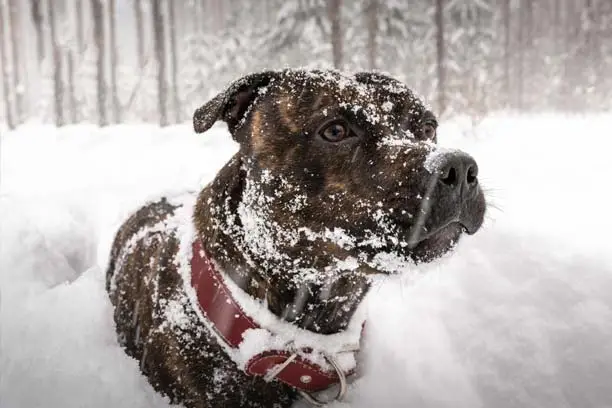7 Ways to Keep Dogs Safe in Cold Weather


Even when it’s chilly or snowy outside, dogs need exercise and the mental stimulation they get from being outside. But they can be prone to winter-weather-related health issues, like frostbite, and they depend on you to help them stay safe. Start with these seven tips.
Depending on your dog’s breed, you may have to shorten your walks or your outdoor time. Large or arctic dog breeds can be outside in the cold for 30 minutes or more, while smaller dogs shouldn’t be outside for more than 10 to 15 minutes in temperatures below 32ºF.
Your climate matters, too. A dog that’s used to going outdoors every day as the seasons change will be more comfortable than one that recently moved to a cold climate.
Be sure to play with your dog indoors so they can burn off energy and don’t get bored.
It’s usually warmest in the afternoon, so if you can manage it with your work or school schedule, walk your dog at lunchtime or soon after. You’ll both be a lot more comfortable, especially if the sun is shining.
If you can’t walk then, consider taking longer daytime walks on the weekends and shorter walks on weekday mornings or evenings. You may also want to take several short walks, with breaks indoors so you can warm up, instead of one long walk.
Winter days are shorter. When you’re walking your dog at dusk, dawn or dark, be sure to wear reflective clothing and to carry a flashlight so drivers can easily see you. You may also want a reflective or light-up collar or leash for your dog.
When your dog is in freezing weather, they might need protection against the cold. They can’t tell you if they’re chilly or uncomfortable, but their fur may not be enough to keep them warm. Generally, smaller dogs get cold more easily, as do dogs with light or close-trimmed fur. Older dogs may also need a sweater or jacket to stay warm and comfortable. Bigger, furrier dogs might get overheated with clothing, so you might be able to skip it.
Consider winter boots, too. Your dog might take some time to get used to them, but boots can protect their footpads. It’s not just the temperature you need to worry about. Slush and snow can build up between your dog’s toes and make them uncomfortable. Salt, sand and other melting agents that get put on sidewalks and roads can also cause foot irritation.
There’s no good time of year for your dog to get lost, but winter is especially dangerous. Make sure your dog’s tags are always attached and updated if you move or change your phone number. Have your vet scan your dog’s chip once a year to make sure it’s working properly. These steps can help ensure your dog makes it home quickly and safely if you ever get separated.
If you keep your house cool to save on your heating bills, consider having cozy areas with dog beds and blankets near vents where your dog can keep warm. Some dogs may also benefit from a light sweater indoors.
It’s not always easy to know when your dog is uncomfortable. Your dog might be so excited to be with you or to be outside — or both — that they don’t show any signs they are chilly. Ask your vet if your dog can be outside in the cold. Your vet knows your dog’s size, breed, age, fur condition and disposition and can recommend the temperatures and weather conditions when it’s safe for your dog to be outside.
Winter weather isn’t just dangerous for pets. From heavy snow to ice dams to frozen pipes, your home faces risks from winter weather, too. Talk to a Farm Bureau insurance agent about the best ways to protect your property from winter damage.